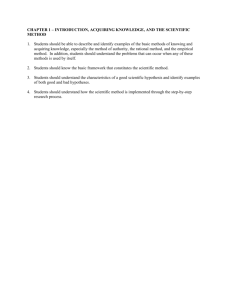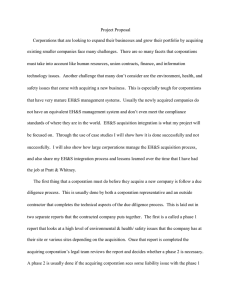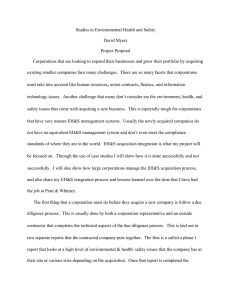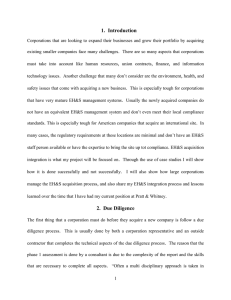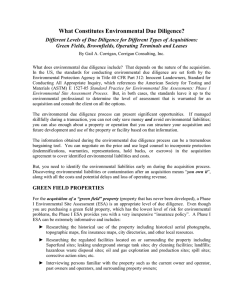1. Introduction .
advertisement
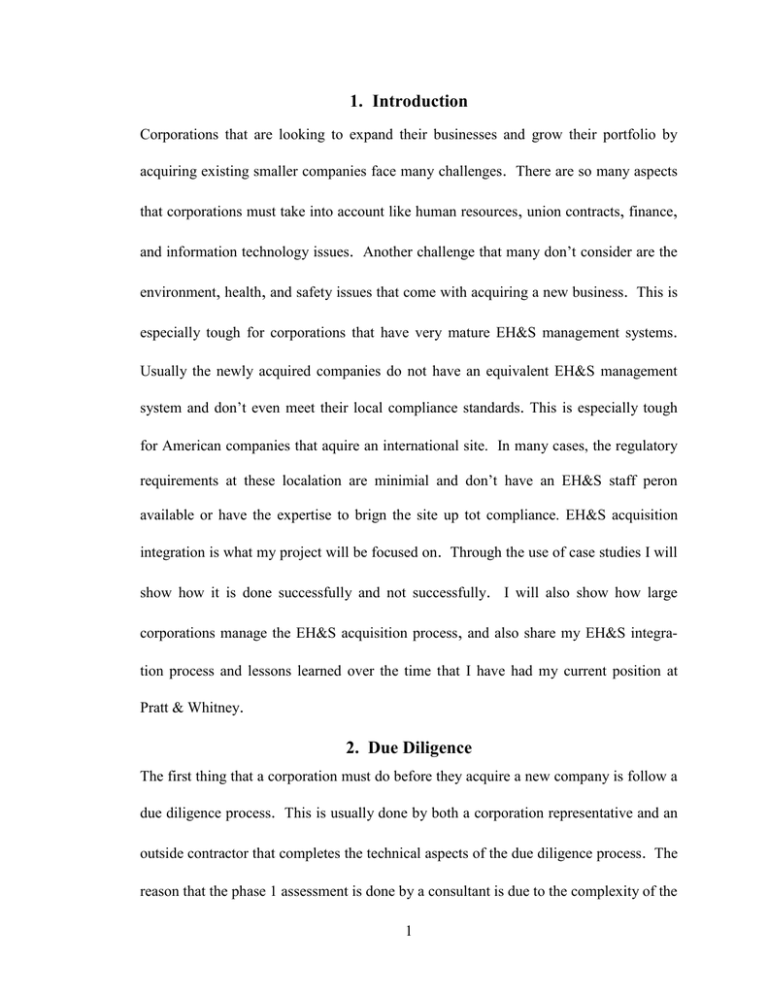
1. Introduction Corporations that are looking to expand their businesses and grow their portfolio by acquiring existing smaller companies face many challenges. There are so many aspects that corporations must take into account like human resources, union contracts, finance, and information technology issues. Another challenge that many don’t consider are the environment, health, and safety issues that come with acquiring a new business. This is especially tough for corporations that have very mature EH&S management systems. Usually the newly acquired companies do not have an equivalent EH&S management system and don’t even meet their local compliance standards. This is especially tough for American companies that aquire an international site. In many cases, the regulatory requirements at these localation are minimial and don’t have an EH&S staff peron available or have the expertise to brign the site up tot compliance. EH&S acquisition integration is what my project will be focused on. Through the use of case studies I will show how it is done successfully and not successfully. I will also show how large corporations manage the EH&S acquisition process, and also share my EH&S integration process and lessons learned over the time that I have had my current position at Pratt & Whitney. 2. Due Diligence The first thing that a corporation must do before they acquire a new company is follow a due diligence process. This is usually done by both a corporation representative and an outside contractor that completes the technical aspects of the due diligence process. The reason that the phase 1 assessment is done by a consultant is due to the complexity of the 1 report and the skills that are necessary to complete all aspects. “Often a multi disciplinary approach is taken in compiling all the components of the phase 1 study, since skills in the chemistry, atmospheric physics, microbiology and even botany are frequently required. Many of the preparers are environmental scientists.1 This is such a common report now that the ASTM has a specific standard on a phase 1 assessment, and who can do one. “Under ASTM E 1527-05 parameters were set forth as to who is qualified to perform Phase 1 ESA’s. The new parameter defined an Environmental Professional as someone with 1) a current Professional Engineer’s or Professional Geologists license or registration from a state or U.S. territory with 3 years equivalent full-time experience; 2) have a Baccalaureate or higher degree from an accredited institution of higher education in a discipline of engineering or science and 5 years equivalent experience; or 3) have the equivalent of 10 years full-time experience.”2 This is laid out in two separate reports that the contracted company puts together. That phase 1 report consists of: Depending upon precise protocols utilized, there are a number of variations in the scope of a Phase I study. The tasks listed here are extremely common to almost all Phase I ESAs: 1 2 Performance of an on-site visit to view present conditions (chemical spill residue, die-back of vegetation, etc) hazardous substances or petroleum products usage (presence of above ground or underground storage tanks, storage of acids, etc.); and evaluate any likely environmentally hazardous site history. Evaluation of risks of neighboring properties upon the subject property Interview of persons knowledgeable regarding the property history (past owners, present owner, key site manager, present tenants, neighbors). Wiki Wiki 2 Examine municipal or county planning files to check prior land usage and permits granted Conduct file searches with public agencies (State water board, fire department, county health department, etc) having oversight relative to water quality and soil contamination issues. Examine historic aerial photography of the vicinity. Examine current USGS maps to scrutinize drainage patterns and topography. Examine chain-of-title for Environmental Liens and/or Activity and Land Use Limitations (AULs).3 The first is a called a phase 1 report that looks at a high level of environmental & health/ safety issues that the company has at their site or various sites depending on the acquisition. Real estate holding which identifies potential or existing environmental contamination liabilities. The analysis, often called a Phase I ESA, typically addresses both the underlying land as well as physical improvements to the property; however, techniques applied in a Phase I ESA never include actual collection of physical samples or chemical analyses of any kind. Once that report is completed the acquiring corporation’s legal team reviews the report and decides whether a phase 2 is necessary. Phase 2 Environmental Site Assessment reports are sometimes required when a Recognized Environmental Condition (REC) is found during the Phase 1 Environmental Assessment process. Phase 2 Environmental Assessments consist of collecting soil samples to screen for chemical or metal contamination. This sampling is conducted by drill rig, hydraulic push, hand auger or backhoe, depending on site specific conditions. Phase 2 Environmental reports can also include sampling of groundwater and surface water. This testing is recommended when there is a significant potential for the existence of an environmental liability that can affect the value of a property. Environmental liabilities are costs 3 Wiki 3 associated with regulatory-mandated cleanup, disposal of regulated-waste and civil liability. Civil liability occurs when the contamination has migrated offsite or tenants sue over exposure to hazardous materials.4 This is a common question and there is not a simple answer. The ASTM standard describes a recognized environmental condition as the presence or likely presence of any hazardous substances or petroleum products on a property under conditions that indicate an existing release, a past release, or a material threat of a release of any hazardous substances or petroleum products into structures on the property or into the ground, ground water, or surface water of the property.5 The term includes hazardous substances or petroleum products even under conditions in compliance with laws. In general, previous uses that can typically create the need for a Phase 2 Environmental Study include: gas stations, dry cleaners, machine shops, manufacturing, hazardous waste storage, etc. Further analysis into the specific site details during the Phase 1 Environmental process will determine, if any of these previous uses have created a significant potential for a release or if a known release has occurred. Expertise in soil and groundwater contamination is required in order to make good judgments in regards to these matters. Many corporations will automatically require a Phase 2 Environmental investigation for a property that has had any of these environmentally-sensitive uses. These studies can range from Limited Phase II Environmental Assessments to full Phase II Environmental Studies, that include installation of groundwater monitoring wells with extensive testing. As part of the due diligence process for real estate transactions, a more limited study should be conducted as a screen initially to determine if there is a severe problem. If this is the case, further site characterization 4 5 AAI AAI 4 may be required or this can help the buyer decide if he wants to go forward with the transaction.6 A phase 2 is usually done if the acquiring corporation sees some liability issue with the phase 1 report. The phase 2 report will focus on those liability issues from the phase 1 report. Once the phase 2 is completed the acquiring corporation will review and decide on any conditions that they would like to put on the deal. This is usually done with reserves that are set aside for future liabilities that may present themselves after the deal is complete. If the lab results from the soil, water or groundwater samples indicate a significant problem, need further delineation or if cleanup is required by an agency or by the responsible party, a site characterization, risk assessment or remediation may be required. The remediation or cleanup typically has to occur until verification samples are less than federal, state or local cleanup standards. In some cases the owner or occupant wants to completely remove all contaminants to non-detectable, if it is feasible. Case Studies Shore Realty/UTC Fire & Security 6 AAI 5 3. Integration Once this is all agreed upon the deal is done and the hard work begins. One of the issues with the due diligence process is confidentiality and not all the right players are usually involved with the decision making process. This is done at the executive and legal levels. All they are going on are the phase 1 & 2 reports, and the advice of the EH&S Vice president. Executives have a 30,000 foot level view of the acquisition, and can’t see the real EH&S issues of the acquisition as a trained day to day EH&S professional can do by spending time with the acquisition leadership and local EH&S professional. Usually the decision to acquire the new business is made for financial reasons unless there are strikingly large environmental or safety issues from the reports. This is where the EH&S compliance manager or EH&S acquisition integration manager get involved and starts the internal process of EH&S integration with the new company. The first area that the integration process will focus on is compliance. The new company will undergo a compliance audit at the newly acquired site or sites. This can be a complicated process depending on the acquisition because of the different country laws and regulations that need to be considered during the compliance audit process. This is either done by the compliance department of the acquiring company if they have experience in the area or they will have a contractor in the area do it so that there is some expertise in the compliance audit. Once the compliance issues are identified a corrective action. 6

